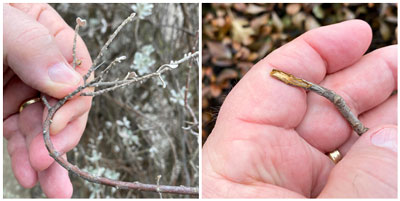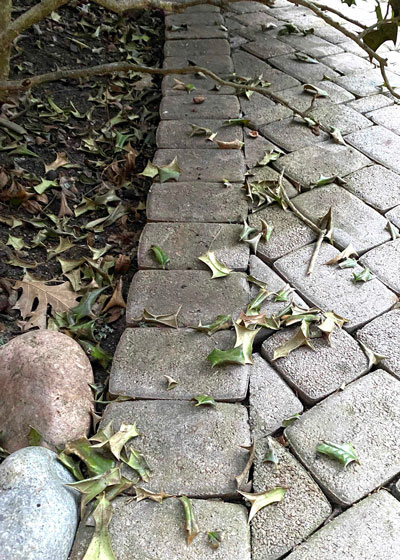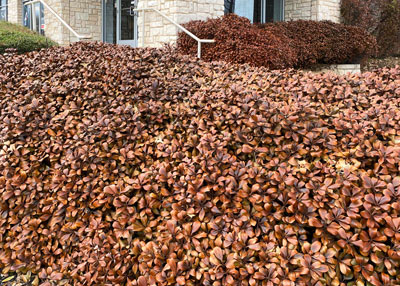Four Weeks into the Thaw
Four weeks ago we wondered if any parts of our landscapes would show up for spring.
The answer is “Yes!”
In fact, last Friday I asked friends on my Facebook page to show signs of life from their own landscapes and gardens, and the results were astounding. 77,000 people looked at it. They posted many hundreds of photos of plants budding and blooming. It was a time to celebrate hope and recovery. In fact, here is a link that post and to their hundreds of posts. (And this was six days ago!)
This has been a rough month for all of us in this business. Texas Certified Nursery Professionals (at member nurseries of the Texas Nursery and Landscape Association) have seen the public day after day. I’m sure they’ve answered the same question I have hundreds of times: “Is my plant dead?”
By the way: Those TCNPs are your best source of localized, reliable information – and nursery stock. They’re the professionals, and they work in your town’s independent retail garden centers. Their advice is timely and reliable!
That said, enough time has now passed that we can probably begin to tell for ourselves whether a plant has survived intact, been wounded in action, or is in need of replacement.

Common plants and what you might assume…
Let me draw some conclusions based on what I’ve seen from your posts, witnessed in my own landscape (DFW area) and heard on the street.
I’ve chosen common Texas landscaping plants and I’ll tell you what you’re likely to find as we approach the middle of March.
Vines
• Carolina jessamine: Normally winter-hardy into North Central Texas, this vine seems to have been killed in areas where it has previously thrived. If it’s brown, plan to replace it.
• Star jasmine: If their leaves are brown and crisp the plants have probably been lost. It rarely comes back from its roots.
Groundcovers
• Asian jasmine: Its tops turned brown over most of the state. Mow or trim it to 1-2 inches. It should come back.
• Liriope: Hopefully you have already trimmed it back to remove browned leaves as recommended here in previous e-gardens. My plants are sending up new growth already.
Shrubs
• Abelias of various types: Folks reported them coming back on my Facebook page last Friday, and they brought photos to prove it.
• Azaleas of various types: Most will probably be fine, but you may need to prune to reshape them after their blooming time.
• Bottlebrush: If it turned brown, it’s almost assuredly gone. It’s really not as winter-hardy as many assumed. It’s a South Texas plant only.
• Crape myrtles of various varieties: It’s still too soon to know. If first signs of new growth later this month show up at the base, leave those shoots for a few weeks. They may indicate dieback. A few varieties (most commonly Natchez, Tuscarora, Muskogee and Sioux, but could include others) are prone to cold damage. If they’re reluctant to send out new growth along their upper stems, those basal shoots may be all that you have to train as new trunks. But they’ll regrow very quickly.
• Gardenia: If they’re brown, they’re probably gone. If they were going to send out new buds they should be doing so by now. I rarely see that happen.


• Hollies of various types: I see leaf drop all over mine, but I’ve seen that in many other winters. I have 12-15 regular yaupon trees, and several of them have turned brown. I looked at them this morning and they’re all getting ready to send out new growth. Sit tight on yaupons. (As I am on my other 25-30 types of hollies. They’ll look great within 3-4 weeks.)

• Indian hawthorn: If they’re brown, they’re probably gone. North Central Texas where I live had a huge mortality rate – 90 percent or higher lost in the neighborhoods I drive. This plant has a problem with the fatal Entomosporium fungal leaf spot anyway. You probably should replace it with some other type of plant. Let your Texas Certified Nursery Professional guide you.
• Japanese ligustrum and privet: These were completely defoliated over a big swath of Texas. It’s possible some of the Japanese ligustrums might even have been killed in northern parts of the state. That wouldn’t be a bad thing. Both of these plants are horrifically invasive due to birds spreading their seeds.
• Japanese yew: These have slowly been turning brown even in South Texas. We’re going to see a large percent of them lost.
• Loquat: These are lovely large evergreen shrubs or small trees. Unfortunately, their beauty causes many of us to plant them way north of where they’re adapted, and this February was our awakening. Most of the ones that turned completely brown have been lost, probably in parts of the state where they’ve never been hurt before.
• Loropetalum (fringeflower): Their leaves turned brown as soon as temperatures rose, but new growth is already coming out. You may want to shear to tidy them up, but let them have their natural growth form. Avoid square or round trimming.
• Nandinas of various types: I’ve already trimmed my compact nandinas back to 3-4 inches. That was just a week ago and they’re just barely starting the resprout. They’ll come bounding back before the end of March. I told them so as I visited them before writing this this morning.
• Oleander: If their stems are shriveled and their leaves are browned, you might as well cut them to 3-4 inches. They’re alive. The tops are gone, but the plants will send out vigorous new shoots from their roots.
• Pampasgrass: Normally evergreen, this grass froze in much of the state. You need to use a machete to cut off the browned leaves. Wear gloves and long sleeves to protect yourself from the razor-sharp blades. Trim to 18 inches, but don’t cut new leaves that may already be growing.
• Pittosporum: If the plants turned brown, they’re gone. I pronounced this as the first known casualty to the freeze. They go quickly and visibly after really hard freezes, and they don’t come back. I grew up in College Station and I didn’t see that happen in those 20 years there, but my landscape in DFW got slammed when I counted on these plants farther north. This February, much of Texas “enjoyed” a DFW winter and the pittosporums suffered.
• Sago palm: Trim off the dead leaves as mentioned a week or two ago here. Leave the crown in place unless it softens. Hopefully it will put out new leaves as it starts to warm up.
• Texas mountain laurel: Wait to see if browned leaves are replaced with new growth if you have this plant north of its native range.

• Texas sage: I thought these plants were goners in North Central Texas. I’ve seen them lost in cold winters before. Most of their leaves turned crisp after the thaw, but to my chagrin, when I looked at some yesterday, new growth is starting to show. You’ll probably want to trim these plants to thicken them up if they lost most of their foliage, but it’s OK to wait another week or two to decide.
• Waxleaf ligustrum: These were brutalized in the northern half of the state or even beyond. Don’t be shocked if you have to replace them with dwarf Burford holly, Willowleaf holly or some other suitable substitute (not redtip photinia!). Or, if your waxleafs stage a comeback, prune them to make them dense and full.
Trees
• Palms of various types: Damage to these may not show completely until summer. Remove dead leaves and leave trunks in place for a few months to see.
• Live oak: As stated several times prior here, these will come back. They still look terrible in much of the state, but don’t anguish. They all drop all of their leaves in the spring every year anyway. They just did it in a hurry this year.
• Slash and loblolly pines: The Texas Forest Service of Texas A&M tells us that the freeze damage observed in East Texas will, in most cases, resolve as the trees put out new growth this spring. They should be fine.
Lawns
• St. Augustine: I’m still waiting and watching. Anyone in South Texas can already tell. If runners are alive and rooted firmly to the ground, then your turf will be fine. If you don’t see green runners, and if they’re dry and pull loose easily from the soil, that’s a big concern. You’ll know fairly soon. (Watch out for a big run on sod this year as folks replant lost turf.)
• Bermuda, zoysia and buffalograss should not have been affected by the cold. Those grasses are all winter-hardy to temperatures and weather conditions Texas encountered in February.
Friends, these are just one guy’s educated opinions on all of these plants. I hope you find them useful. Your local experts will always be your best source of help, and for the third time I’ll send you to Texas Certified Nursery Professionals at members of the Texas Association of Nurserymen. They’ll have name badges and you should see signage at the nurseries.
